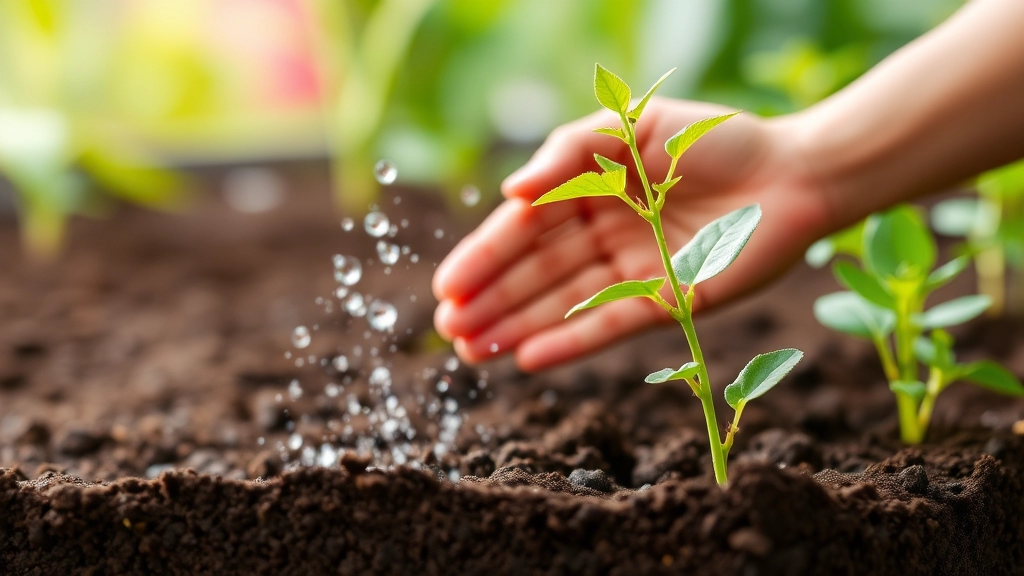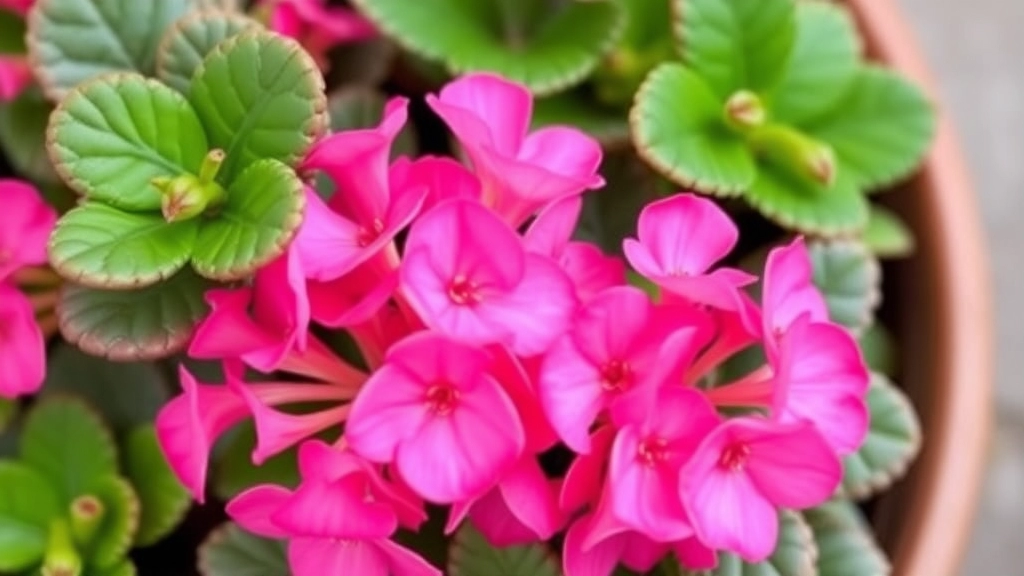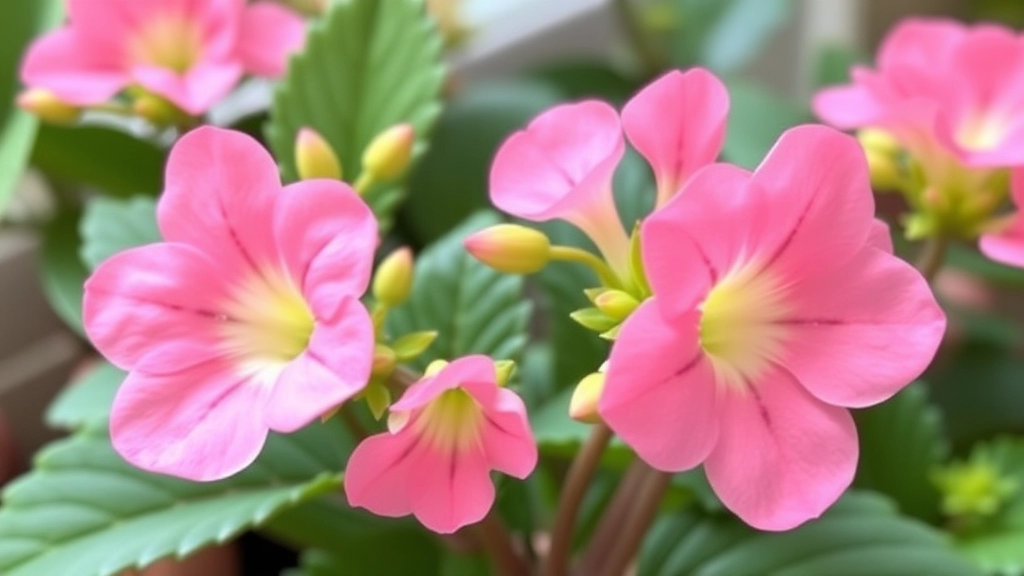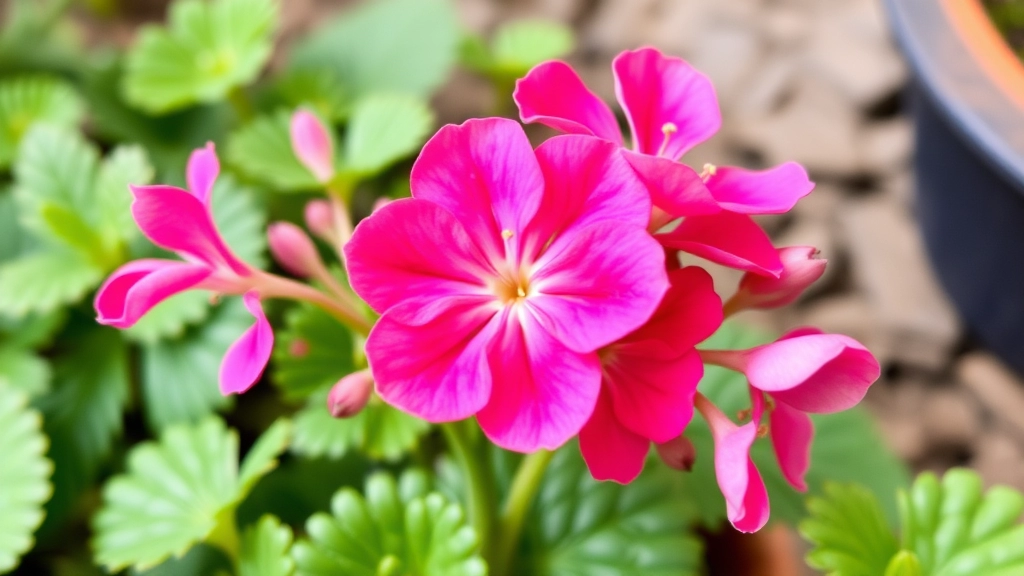Pink Flower Kalanchoe Care Guide
If you’re looking to add a splash of vibrant colour to your home or garden, the Pink Flower Kalanchoe is a fantastic choice. Known for its striking pink blooms, this plant not only brightens up any space but is also relatively easy to care for. In this guide, I’ll walk you through the best growing conditions, watering needs, and light requirements for your Pink Flower Kalanchoe to thrive.
Ideal Growing Conditions
First things first, let’s talk about the ideal growing conditions. The Pink Flower Kalanchoe prefers well-draining soil and a pot with good drainage. Overwatering can lead to root rot, so it’s crucial to let the soil dry out between waterings.
Light Requirements
When it comes to sunlight, this plant loves bright, indirect light. Too much direct sunlight can scorch the leaves, while too little can result in leggy growth and fewer blooms. Keep the temperatures moderate, ideally between 15°C and 24°C, to ensure your Kalanchoe stays happy and healthy.
Best Growing Conditions for Pink Flower Kalanchoe
When it comes to cultivating a vibrant Pink Flower Kalanchoe, many of us wonder: what are the ideal conditions for these beautiful plants?
To ensure your Kalanchoe thrives, consider the following essential factors:
Watering and Soil Requirements for Healthy Growth

So, you’ve got your lovely pink flower Kalanchoe, and now you’re probably wondering, “How much water does it really need?” or “What kind of soil will keep it thriving?”
Let’s dive into these essentials.
Watering Your Pink Kalanchoe
Watering is one of the trickiest parts of caring for Kalanchoe. Too much, and you risk root rot; too little, and it’ll droop like a sad puppy. Here’s how to get it just right:
- Frequency: Water every 2-3 weeks in the growing season (spring and summer). In winter, cut back to once a month.
- Check the Soil: Always stick your finger about an inch into the soil. If it feels dry, it’s time for a drink!
- Watering Technique: Water deeply but let it drain out. Never let it sit in water; your plant will thank you!
Soil Requirements
Now, let’s chat about soil. Kalanchoe loves well-draining soil. Here’s what to look for:
- Type: A cactus or succulent mix will do wonders. You can even make your own by mixing regular potting soil with sand or perlite.
- pH Level: Aim for a slightly acidic to neutral pH (around 6.0 to 7.0). This keeps your plant happy and healthy.
By nailing down watering and soil, you’re setting your pink flower Kalanchoe up for success.
Light and Temperature Needs for Optimal Blooming
When it comes to ensuring your Pink Flower Kalanchoe thrives, understanding its light and temperature requirements is crucial. You might be wondering, “How much light does my Kalanchoe need?” or “What temperature is best for blooming?”
How to Propagate Pink Kalanchoe from Cuttings

If you’re looking to expand your collection of Pink Kalanchoe, propagating from cuttings is a straightforward and rewarding method. Many plant enthusiasts often wonder how to effectively propagate their Kalanchoe, and I’m here to guide you through the process.
Steps for Propagation
- Select Healthy Cuttings
Choose a healthy stem from your existing Pink Kalanchoe. Look for one that is at least 3-4 inches long and has several leaves. - Make the Cut
Using clean, sharp scissors or pruning shears, cut the stem just below a leaf node. This is where roots are likely to develop. - Allow to Callus
Place the cutting in a dry, warm location for a few hours or overnight. This allows the cut end to form a callus, reducing the risk of rot when planted. - Prepare the Soil
Use a well-draining soil mix, ideally a cactus or succulent blend. This ensures that excess moisture doesn’t linger around the roots. - Plant the Cutting
Insert the callused end of the cutting into the soil, burying it about an inch deep. Gently press the soil around the base to secure it. - Water Sparingly
Lightly water the soil to settle it around the cutting. Avoid overwatering; the soil should be moist but not soggy. - Provide the Right Environment
Place the pot in a warm, bright location but out of direct sunlight. This helps the cutting to establish without being scorched. - Wait for Roots to Develop
After a few weeks, gently tug on the cutting. If you feel resistance, roots are forming. At this point, you can gradually introduce more light.
Tips for Success
- Temperature: Keep the environment warm, ideally between 20-25°C (68-77°F).
- Humidity: A little humidity can help, but avoid excessive moisture.
- Patience: Rooting can take time; don’t rush the process.
By following these steps, you can successfully propagate Pink Kalanchoe and enjoy the satisfaction of nurturing new plants from your existing ones.
Common Issues and Solutions in Kalanchoe Care
Caring for your pink flower Kalanchoe can sometimes feel like navigating a maze. You may find yourself facing a few challenges that can hinder its vibrant growth. Let’s tackle some common issues and their straightforward solutions.
1. Leaf Drop
Problem: If your Kalanchoe’s leaves are dropping, it can be alarming.
Solution:
- Check Watering: Overwatering is often the culprit. Ensure the soil dries out between waterings.
- Adjust Light: Ensure it’s getting enough light. A lack of light can stress the plant.
2. Wilting Leaves
Problem: Wilting leaves can signal distress.
Solution:
- Inspect Soil Moisture: Too much or too little water can cause wilting. Stick your finger in the soil; if it’s dry, water it. If it’s soggy, let it dry out before watering again.
- Temperature Check: Make sure the plant isn’t exposed to drafts or extreme temperatures. Refer to our temperature tolerance guide for optimal conditions.
3. Pest Infestations
Problem: Pests like aphids or mealybugs can invade and damage your Kalanchoe.
Solution:
- Regular Inspection: Check the undersides of leaves regularly.
- Natural Remedies: Use a mixture of water and mild soap to gently wash off pests. Neem oil can also be effective.
4. Fading Blooms
Problem: If your Kalanchoe’s blooms are fading too quickly, it can be disheartening.
Solution:
- Light Requirements: Ensure it’s receiving bright, indirect sunlight.
- Fertilization: Use a balanced fertilizer during the growing season to encourage blooming. For more tips, check out our guide on why your florist Kalanchoe may not be flowering.
5. Root Rot
Problem: Root rot can occur if the plant sits in waterlogged soil.
Solution:
- Repotting: If you suspect root rot, remove the plant from its pot, trim away the affected roots, and repot in fresh, well-draining soil.
- Watering Technique: Always ensure proper drainage in your pots.
Encouraging Re-blooming in Indoor Pink Kalanchoe

So, you’ve got a stunning pink Kalanchoe that has bloomed beautifully, but now you’re left wondering, “How do I get it to bloom again?” You’re not alone in this quest for continuous colour in your home.
Tips for Re-blooming Your Kalanchoe
- Pruning After Blooming
After your Kalanchoe has finished its flowering cycle, give it a little trim.
– Cut back the spent flowers and any leggy growth.
– This encourages new growth and helps the plant focus its energy on blooming again. - Light Adjustment
Kalanchoe loves bright, indirect sunlight.
– Ensure it’s getting at least 6 hours of light a day.
– If it’s not getting enough, consider moving it to a sunnier spot. - Temperature Control
Keep your Kalanchoe in a warm environment.
– Ideal temperatures are between 20-25°C during the day and a tad cooler at night.
– Avoid cold drafts, as they can stress the plant. - Watering Routine
Overwatering can be a killer for Kalanchoe.
– Water only when the top inch of soil feels dry.
– Make sure the pot has good drainage to prevent root rot. - Fertilising
A little boost goes a long way.
– Use a balanced fertiliser every 4-6 weeks during the growing season.
– This helps provide the nutrients needed for those vibrant blooms. - Dark Period
To encourage blooming, mimic the plant’s natural cycle.
– For about 6 weeks, give it 14-15 hours of darkness each night.
– This can trick it into thinking it’s time to bloom again!
Adding a Pink Kalanchoe to your garden or home offers numerous benefits. Its lush green foliage and striking pink blooms can brighten up dull corners, making it a perfect choice for both indoor and outdoor settings. For those who may not have a green thumb, Kalanchoe is a forgiving plant that requires minimal watering and thrives in various soil types. This makes it ideal for busy individuals or those new to gardening. Additionally, Kalanchoe contributes to a healthier living environment by filtering indoor air pollutants. Studies have shown that greenery can reduce stress and enhance feelings of well-being, making a Pink Kalanchoe a daily reminder of nature’s beauty.
For more detailed care instructions, you can refer to the [Pink Kalanchoe Succulent Care and Propagation Guide](https://planthq.org/pink-kalanchoe-succulent-care-and-propagation-guide/). If you’re interested in other varieties, the [Comprehensive Pink Kalanchoe Plant Care Guide](https://planthq.org/comprehensive-pink-kalanchoe-plant-care-guide/) is another excellent resource.
FAQs on Pink Flower Kalanchoe Care
How often should I water my Pink Flower Kalanchoe?
Water your Kalanchoe every 2-3 weeks during the growing season (spring and summer). In winter, reduce watering to once a month. Always check the soil moisture by sticking your finger about an inch into the soil; if it feels dry, it’s time to water.
What type of soil is best for Pink Flower Kalanchoe?
Kalanchoe thrives in well-draining soil. A cactus or succulent mix is ideal. You can also create your own mix by combining regular potting soil with sand or perlite. Aim for a slightly acidic to neutral pH level (around 6.0 to 7.0).
How can I propagate Pink Flower Kalanchoe from cuttings?
To propagate, select a healthy stem at least 3-4 inches long. Cut just below a leaf node and allow the cutting to callus for a few hours. Plant it in well-draining soil and water sparingly. Place the pot in a warm, bright location but out of direct sunlight. Roots should develop in a few weeks.
What are the steps to encourage my Kalanchoe to re-bloom?
To encourage re-blooming:
- Prune after blooming: Trim spent flowers and leggy growth.
- Adjust light: Ensure it gets at least 6 hours of indirect sunlight daily.
- Control temperature: Maintain temperatures between 20-25°C during the day and slightly cooler at night.
- Water properly: Water only when the top inch of soil is dry and ensure good drainage.
- Fertilise: Use a balanced fertiliser every 4-6 weeks during the growing season.
- Provide a dark period: Mimic natural cycles with 14-15 hours of darkness each night for about 6 weeks.
What temperature is ideal for Pink Flower Kalanchoe?
The ideal temperature range for Kalanchoe is between 20-25°C (68-77°F). Keep it in a warm environment and avoid cold drafts to prevent stress.
How do I prevent root rot in my Pink Flower Kalanchoe?
To prevent root rot, ensure you use well-draining soil and a pot with good drainage. Water deeply but allow excess water to drain out completely. Avoid letting the plant sit in standing water.
References
-
Growing Kalanchoe Indoors: Tips for Success
-
Kalanchoe Plant Care: How To Grow Kalanchoe
-
Kalanchoe: How to Grow and Care for Kalanchoe Plants
